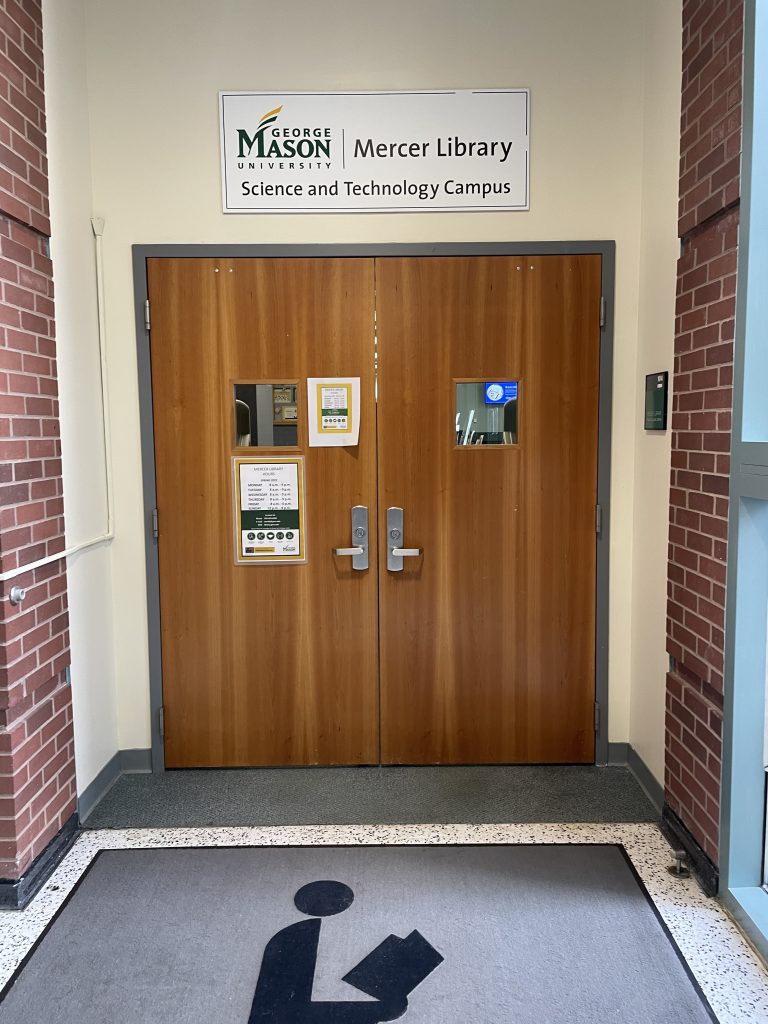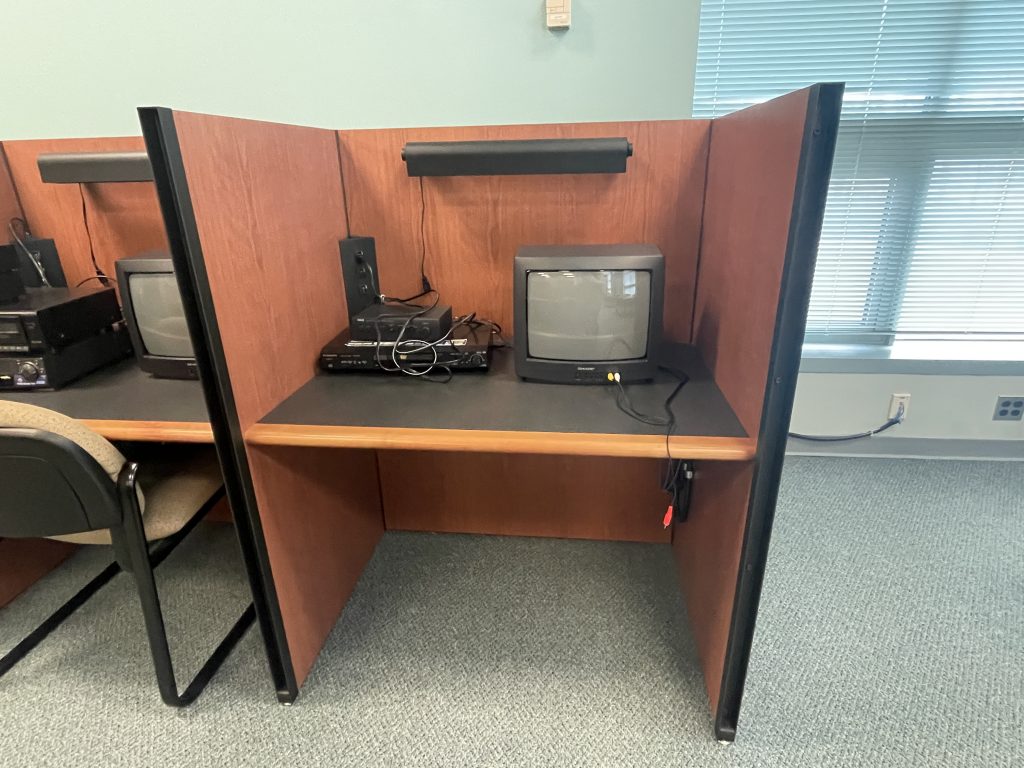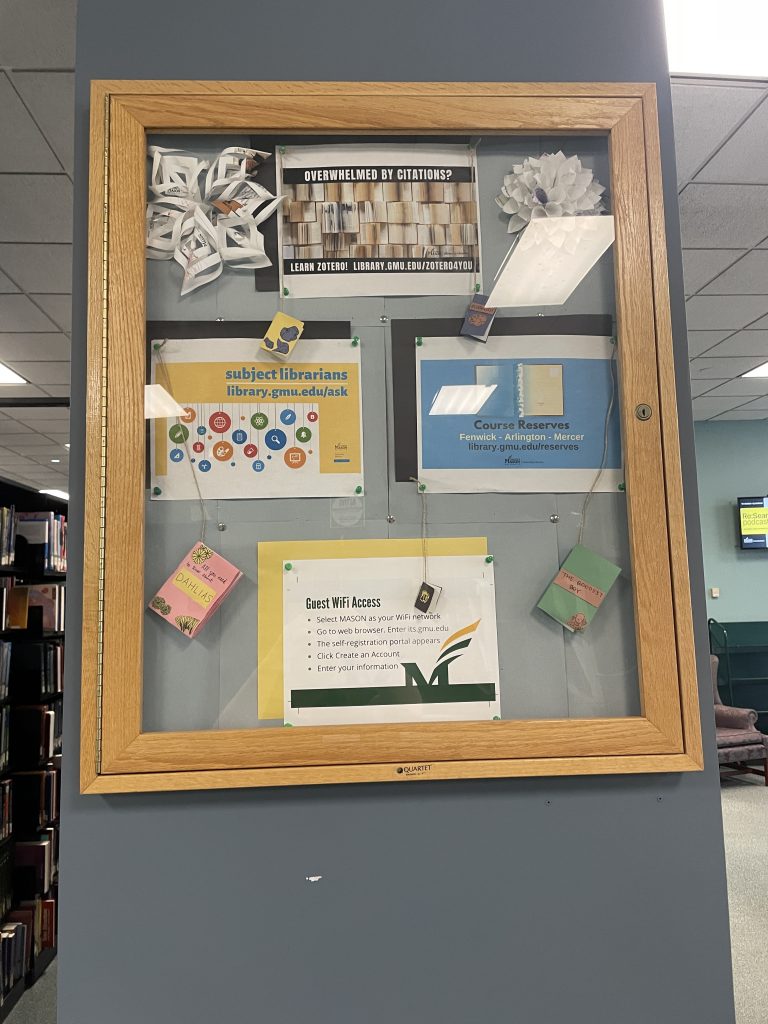For my academic visit, I checked out the Mercer Library on the George Mason University Science and Technology Campus in Manassas, VA. The library website, linked here, is pretty easy to navigate and is laid out in a simple and welcoming way. The library’s catalog search bar is located on the homepage. People can find subject guides, databases, reserves, and journals to access on the website. The website is geared towards GMU students and faculty. There are images of students using the library and an event listed for faculty. The public can also use the website and library but it is not really highlighted on the website.
The website does list the number of staff available for all of the George Mason University libraries. The Mercer Library has 5 staff members listed. Their positions are Research and Instruction Support specialist, library lead, Access Services Assistant and Document Fulfillment Coordinator, Life Science Librarian, and Library Manager. Patrons can connect with the librarians via email, phone, and in person. The website also offers a char function but at the time of my visit, it was down.
The website allows faculty to reserve e-materials for their classes and students. Non-GMU students and faculty can look up materials and sources from the online catalog but they can not borrow items without a student/faculty ID or an account. GMU offers the public the chance to sign up for an account for $150 a year through their Passport Program. The website offers some virtual programming and services such as citation clinics, research tutorials, Adobe product sessions, and virtual tours of spaces and equipment.
The Mercer Library is housed on the first floor of Colgan Hall. The building looks like a lecture hall building. There are a few parking lots across the street from the building that both students, faculty, staff, and the public can park in. Public parking is free for 30 minutes but after those 30 minutes, there is a parking fee. There is also a shuttle/bus stop right outside the building and a few benches. Colgan Hall is named after Senator Chuck Colgan and there is a statue in front of the building to commemorate him.
The library itself has study spaces, computer stations, audiovisual viewing equipment, printers, and a scantron machine. The only limiting space in the library is the study spaces as they need to be reserved in order for patrons to use them. The space seems a bit small and the interior is dark. The library does feel like an academic library but in an unwelcoming way with its dark walls and low lighting. I think the space could do with an upgrade. The space is definitely geared towards adults with the stall shelves and collection of academic and nonfiction sources. I noticed a few handicapped accessible doors to get into Colgan Hall but I did not notice a handicapped accessible door to get into the library.
Academic libraries in the 21st century have revamped what they can offer and have had “an increase in student support services intended to promote student success,” (Rubin & Rubin, 2020, p.171) Inside the library, there were flyers looking for volunteers to be a part of research studies, programs to help with research and citations, and career courses. The library had signage with its operating hours listed, how to read the Library of Congress call numbers, and how to sign onto the building’s Wifi if you are a guest. I found that the guest wifi did not always work and was kicked off of it a few times. The catalog was not made clearly accessible in the building and it seemed patrons had to use a public computer or their own laptop to access the online catalog to find sources in the library. It is clear that the services the library provides and the collection is geared towards college students, GMU faculty and staff, and researchers.
In the library, I noticed most of the patrons were studying at desks on their own personal laptops. I also saw one or two students with an open book next to them doing research and assignments. No one was really interacting with each other. The people at the service desk, who looked to be students, were sitting and talking. The patrons and the staff all looked to be young adults.
The library has a collection of books, journals, and audiovisual resources such as videos. The library has public computers, a printer, scanner, scantron machine, and TVs to view audiovisual resources. The library’s books are mainly nonfiction, reference books focused on Health Sciences, Biology, Criminology, Gaming, Security, and Computer Science. The TVs have VCRs connected to them so patrons can view videos. This to me seems a bit outdated and some younger patrons may not know how to operate a VCR.
Rubin and Rubin (2020, p.170) state that“academic libraries do not have an independent purpose; their functions reflect the mission of the host institution.” Based on the library’s location, collection, and programs, this library is primarily an academic library. Due to it being an academic library, I was surprised at how small the library was in terms of size. The library was not housed in its own building and when I visited it was a bit difficult to find initially. I was a bit disappointed in the offerings the library had. Even though this is not the main GMU campus, I was still expecting a bit more in terms of the number of books in the collection and the size of the library itself.
References
Merico, C. (2022). Image of Mercer Library audiovisual technology. [Photograph]
Merico, C. (2022). Image of Mercer Library front door. [Photograph]
Merico, C. (2022). Image of Mercer Library programs bulletin board. [Photograph]
Rubin, R. R. and Rubin, R. G. (2020). Foundations of library and information science (5th ed.). ALA Neal-Schuman.



I am surprised by the lack of technology and amenities of a library for a big university like George Mason and for the Science and Technology branch. VCRs?? Wow! Regardless of being on the main campus or not, it’s still considered part of the school. I wonder if there is any renovations in the future for this library. The picture you included with the TV just seems to reiterate the need for updated technology and decor for this library. One can only hope that a renovation or more money in the budget is coming to help the library keep up with the times.
I was also surprised by the technology this library had. The VCRs did feel a bit dated and because of that, I wonder how often they actually get used. I am hoping the library does receive a renovation in the future because it seems the offerings didn’t really match with today’s time period.
My first thought was definitely “wow, look at that TV!!” I haven’t seen one of those “in the wild” in a bit, that’s surprising to me to see that AV set up, especially at a university! And the VCRs – traditional college-aged students now definitely didn’t grow up with VCRs so that seems like a bit of a “vintage” setup! It makes me wonder too if there are renovations in the future for this space. You would still think that being affiliated with the university, even if not on the main campus, they would want a space that is inviting and welcoming for students.
I was surprised that even at a satellite location, students would be using a VCR. A DVD or Blu Ray Player seem archaic now. Many commuter students can’t get to the main campus library and this location option may not be enough to meet their needs. I don’t know if I would want to spend the day studying or researching there. Hopefully, like Lisa and Chelsea said, renovations are in the budget. I think students are more likely to use a space and is well lit and open and comfortable.
Hello Caitie!
Wow, it’s amazing to see how different the Manassas Campus library is from the Fairfax Campus library that I have visited! Seeing the VCRs caught me off guard a bit. As others said, I haven’t seen those in a library in a while. It seemed like the library had to be renovated and updated in a lot of things and I hope they get a chance to do that. Having new equipment and books really help patrons enjoy their time in the library, at least for me. I also thought that the Fenwick Library that’s located on the Fairfax Campus was more geared toward GMU faculty and students rather than the general public. Even having the 30-minute free parking and after that, you would have to pay. Also, students could borrow laptops if they had a student ID. So I’m assuming non-GMU patrons would not be able to really do anything in the Fenwick library as well.
Hi Caitie, as others have noted, Mercer’s offerings seem to leave a lot to be desired — it certainly isn’t the glitziest library in our group’s visitation rounds. I also would have thought its association with GMU would give Mercer more capacity to meet the needs of its patrons. As Joyce alluded to in her comment, even expanding the 30-minute free parking limit would go a long way towards fostering a more welcoming atmosphere than the one you observe. I hope that Mercer is in line for its well-needed update soon. Thanks for your honest remarks about your visit!
Like everyone else, I was surprised at the outdated technology at the library. You have to wonder why this library as part of the larger GMU system seems so far behind. Scantrons, DVD players, and that tiny tv-obviously this library has kept up with changes in technology. Even as a satellite campus, is this library meeting the needs of GMU students or are they forced to drive to main campus or the public library.